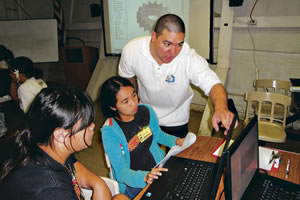Mighty Mo Living Classroom
A veteran of war, battleship USS Missouri now serves Hawaii students as a classroom for history, science, technology, engineering and math. The USS Missouri stands tall in the waters of Pearl Harbor. The ship is a monument of history, as she served our country proudly through three wars. Built for speed and firepower, she made her mark as a pillar of strength and fortitude

By .(JavaScript must be enabled to view this email address)
E-mail this story | Print this page | Archive | RSS

|
The USS Missouri stands tall in the waters of Pearl Harbor. The ship is a monument of history, as she served our country proudly through three wars. Built for speed and firepower, she made her mark as a pillar of strength and fortitude, forging herself mightily through the battles of Iwo Jima and Okinawa, and served as the site of Japan’s surrender Sept. 2, 1945, ending WWII. After continuous reconstruction and modernization overhauls, USS Missouri waged its dominance in Korea in the 1950s as well as in its final operational mission during Operation Desert Storm. In 1995, the Navy donated the Mighty Mo as a memorial museum.
Recently, USS Missouri has taken on a new educational mission. It serves as a venue for students to mold together its architectural history with the advancements and understandings of STEM programs, which include elements of science, technology, engineering and mathematics.
“When the students can get out of the classroom and step aboard this ship, they realize that this is living history as well as real world technology,” says Battleship Missouri Memorial education director Dan Parsons.
This USS Missouri partnership with 3D Academy has begun introducing students to 3D CAD (computer-aided design) programs, allowing them to gain a broader and more detailed understanding of structural and mechanical design.

|
“What we are trying to do is translate real-world applications in the CAD program, showing them (students) how the CAD software would actually be used to create something on the ship,” says 3D Academy president and CEO Collin Kobayashi.
The latest students to be introduced to the battleship workshop were from King Intermediate. The students were taken on a guided historical tour of USS Missouri, getting a visual of the ship’s massively intricate parts, which would later be examined through the 3D CAD design program. For example, students got to compare the actual gun turrets on the ship to their technological design, shown through the 3D CAD computer program.
“The students were able to see the gun turret, but what you don’t see is that mechanically it spins side to side. Part of what drives the gun turret are different types of steering systems,” says Kobayashi.
“We were able to show the students different types of gears, what they are used for, and how it would be integrated to different parts of the ship.”
One of the main goals of the workshop is to help students understand how each portion of STEM programs works cohesively to create a functioning design, engineered for its mechanical purpose.

|
“Being able to apply different types of depth skills, and to be able to see how all those parts are built and being hands-on is definitely going to benefit the students in life,” Kobayashi adds.
The 3D CAD program allows students to apply each section of the STEM program individually to the design assignments of the overall mechanics of each part. During the workshop, students had to figure out scientifically which metals would be the most appropriate in terms of mass, density and center of gravity. Mathematically, students evaluated the correct gear positioning as it relates to angles and spacing of gear placement. Relating to engineering and technology, students applied the functionality of the gear within the 3D CAD software, theorizing how and whether it would function properly.
When asked what his favorite part of the workshop was, King Intermediate seventh-grader Matthew Iseri says, “3D CAD was cool because it allowed us to visualize the design in 3D and not just in a flat 2D view.”
When Parsons was appointed to his position in 2008, one of his directives was to tie the history of the ship to different elements of learning.
“We were cruising right along, but we wanted to find ways to include the STEM areas because that is where our students are lacking,” he says. “We hear our U.S. students are behind in math and science, so one way we wanted to focus our attention was to see ourselves as a platform for STEM programs.”
Expanding upon the 3D CAD program, USS
Page 1 of 2 pages for this story 1 2 >
E-mail this story | Print this page | Comments (0) | Archive | RSS
Most Recent Comment(s):








